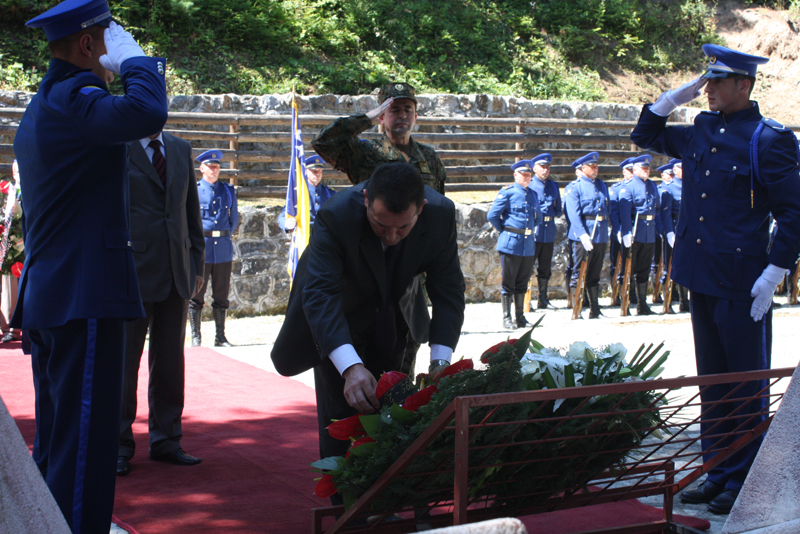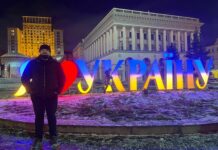16th Anniversary of the death of US diplomats and French soldier in Igman
The Tragic Event that Led to Peace Negotiations
Written by: Daniel Omeragić
{artsexylightbox}Once again, on 19th August, at the Igman Memorial, honor was paid to three US diplomats – Assistant Defense Secretary Joseph Kruzel (1945), Special Envoy for Former Yugoslavia Robert Frasure (192) and US Military Air Force Colonel Samuel Nelson Drew (1948) – as well as French soldier Stephan Reault (1975), who lost their lives in 1995 when coming to a peace mission in Sarajevo.
Following the steep and curvy cobble stone road going from Hrasnica up the mountain, rising above the Sarajevo field, numerous delegations, representatives of Bosnia and Herzegovina, Federation of BiH, Sarajevo Canton and the City of Sarajevo, as well as the US and French Embassies came to lay wreaths on the place where these four brave men were killed, remembering also their role in finalizing the war. It is the same road the creator of the Dayton Agreement, Richard Holbrooke described in the introduction part of his memoir book “To End a War” as the most dangerous in Europe.
The most dangerous road in Europe
“The Mount Igman route to Sarajevo was often described as the most dangerous road in Europe. Parts of the road, a narrow, winding, red-dirt track originally used only by farmers and shepherds, were controlled by Serb machine gunners, who regularly shot at U.N. vehicles trying to reach the Bosnian capital. The roadbed itself had little foundation and no reinforcement along its sides, and in several of its narrower sections it was difficult for two cars to pass each other. The wreckage of vehicles that had slid off the road or been hit by Serb gunners littered the steep slopes and ravines. In the summer of 1995, however, with the airport closed by Serb artillery, the two-hour drive over Mount Igman was the only way to reach Sarajevo without going through Bosnian Serb lines.
The Chief European negotiator, Carl Bildt of Sweden, had been shot at crossing Serb territory only weeks earlier. He urged us not to use the Igman road. But without visiting the Bosnia’s beleaguered capital we could not carry out our mission. On August 15, we made our first attempt, taking a United Nations helicopter from the Croatian coastal town of Split to a landing zone high on Mount Igman, after which we would drive in armored vehicles to Sarajevo. Our helicopter was unable to find a break in the heavy clouds over the landing site. After circling for several unpleasant hours, we returned, frustrated and tired, to Split …“, wrote Holbrooke.
The US Mission members had previously attended negotiations in Belgrade with Serbian President Slobodan Milošević, from whom they had tried to get guarantees for their safe arrival in Sarajevo which was besieged by Serb forces.
“It is disgraceful that President Clinton’s peace mission has to travel to Sarajevo by such a slow and dangerous route. In order to negotiate e must be able to move rapidly between here and Sarajevo. We have already been in the area for almost a week and we haven’t been able to get there. It is ridiculous. You claim to want peace. I ask you now to arrange for us to fly to Sarajevo or to guarantee that we can use a safer land route without any interference from the Bosnian Serbs,” Holbrooke requested from Milošević.
After Milošević answered that he could not provide guarantees, but instead he would ask the Commander of Bosnian Serb Army, Ratko Mladić not to cause problems, Holbrooke and Freiser agreed that they had no other choice but to fly by helicopter via Split to Igman and then to Sarajevo. The flight was without any problems. However, at one of the narrow curves, the French Army transporter which was supposed to take them to Sarajevo and in which the three US diplomats were sitting, slipped into a deep abyss.
Going out from dead end street
Kruzel, Frasure and Drew were the first Americans who lost their lives during the war in Bosnia and Herzegovina. Their tragic death only strengthened the United States of America further and in summer 1995 they started a strong diplomatic activity in the Balkans, convinced that it was necessary to establish peace as soon as possible.
US State Secretary Assistant at the time, Richard Holbrooke visited Sarajevo on 8th and 9th January 1995. The purpose of his visit, as he pointed out, was to confirm support to integrity of RBiH and consider the future plans of the Contact Group. The Head of French diplomacy, Alan Juppe stated in French Le Monde on late January that year, that the only way of getting out of the dead-end street that the Contact Group was in, would be organizating a summit of the main protagonists of the tragedy and a new international conference. Such a decision of the European Union, which put the crisis in BiH in a broader context, was a result of the previous summit in Munich on the topic of support to the Federation of BiH, which was a precondition for successful end of peace process in Bosnia and Herzegovina. The meeting in the Bavarian capital – which was the first verification of the Project of the Federation of BiH by the European Union – was chaired by Holbrooke.
This represented the final agreement of positions between USA as a mentor in conclusion of the Washington Agreement, and formation of FBiH and the Contact Group members which, in addition to the USA, included Russia, the United Kingdom, France and Germany. The diplomatic activity of EU, that is, the Contact Group in the first half of 1995, also detailed in the book “Bosnia and Herzegovina from Vanco Mission to Dayton Agreement” by Prof Dr Kasim Begić, addressed two issues to Milošević: pressure for acknowledgment of the Republic of BiH by so called FRY in exchange for suspension of sanctions, and initiation of tripartite meeting of Izetbegović, Tuđman and Milošević, which would be the beginning of a new peace process.
During the discussion in the Committee of Foreign Policy and Security of the European Parliament on 20th February 1995, Juppe adressed these issues by stating the following:
“FRY must recognize BiH in its present, internationally recognized borders, which would suppress ambitions of the East for territorial expansion towards BiH.”
|
Joseph Kruzel |
Nelson Drew |
robert freiser |
Markale Massacre
However, the events on the battlefield got even more tragic. Serb occupation and attacks on UN protected zones continued, culminating in July 1995 by the occupation of Srebrenica and killing of more than 8,500 Bosniacs. Later, this event was recognized as genocide by the ICTY verdicts. The artillery attacks on Sarajevo from Serb positions became more severe. 43 people were killed and 84 people were suverely wounded in the massacre at the entrance to City Market Markale on 28 August 1995. The USA described this artillery attack as crime against humanity, and the State Department Media Representative, Nicholas Burns in his press release pointed out that the USA firmly sticked to the obligations taken at the London Conference and NATO Summit, and made clear that Washington believed that Bosnian Serbs were responsible for the shelling in spite of denial from their officials.
Shelling of the Markale market repulsed the other Contact Group members. German Foreign Minister Klaus Kinkel said that the perpetrators of the barbarian attack had to be charged and face the consequences. As Spain chaired the EU at the time, the Spanish Ministry of Foreign Affairs reacted with a press release in which they stated that those who were responsible for the massacre would pay for their crimes. The UN Secretary General Boutros Ghali ordered the military commanders of UN ground forces to take an action against those who were responsible for killing civilians.
Early morning on 29 August 1995, NATO planes started bombing Serb positions around Sarajevo, after UN concluded that the brutal machine gun attack came from that direction. NATO South Command in Naples announced that more than 60 planes took part in the “Nigh Flight” Action and that according to the first information, most targets were destroyed or damaged. The main targets were the points that could put the whole action at risk, which primarily referred to air defense, rocket, radar and telecommunication systems, as well as storages of ammunition and weapons. This was an action of great importance for NATO itself, which thereby, after the fall of “Iron Curtain” and the disappearance of Warsaw Pact, found the purpose of its existence again.
The participants in the operation were also Rapid Reaction Force units (RRF), which were formed by the French President Jacques Chirac who, as Holbrooke wrote, wanted to show Serbs that France was up for a more aggressive policy. After the first day, NATO Secretary General Willy Claes said that he could confirm the readiness for continuing, even strengthening the military action if Bosnian Serbs didn’t show enough good will to respect the rules of the game as defined by the Security Council. At the meeting with French Ambassadors, President Chirac pointed out that the besiege of Sarajevo had to end, and that, in the first phase, safe access to the city had to be provided, not only by complete protection of the Igman Road, but also by controling the road from Kiseljak.
The action will show Serbs that they could lose everything and get nothing if they continue attacking Sarajevo and other safe areas, and killing innocent civilians, said the US President Bill Clinton.
Bombing Serb positions around Sarajevo, which was strongly opposed by Russia, stopped after a few days with the so called Holbrooke’s Agreement, after long talks and upon a proposal of the Serb side. UN requested the Bosnian Serbs to remove artillery to the distance of 20 kilometers from the Sarajevo city center, stop shelling civilian targets and terminate all activities. Although Sarajevo remained in almost unchanged position and surrounded by the part of heavy weapons – which is why UNPROFOR Commander Rupert Smith expressed his dissatisfaction – the agreement was made.
Still, the NATO and RRF action had greater effects in respect of reducing the imbalance in weapons and combat power between the “sides in conflict”. The Agreement on ceasefire in the whole BiH was made on 5 October 1995, after it was signed by the President of BH Presidency at the time, Alija Izetbegović and Holbrooke. The ceasefire would last 60 days or until the end of peace negotiations and a peace conference –stated the Agreement which was put in force on 10th October. This was preceded by joint operations of RBiH, HVO and Croat Army on the battlefields in West Bosnia and the successes of the Army of BiH on the ground in Central Bosnia which changed the course of the war.
In the meantime, the so called shuttle diplomacy was led by the USA and its chief negotiator Holbrooke in the triangle Zagreb – Belgrade – Sarajevo. Its crown was the Dayton Agreement signed on 21 November 1995, ending the war in Bosnia and Herzegovina.
Continuation of noble task
– Today we mark the 16th anniversary of death of three Americans, Ambassador Robert Frasure, Dr Joseph Kruzel and Colonel Nelson Dre, who lost their lives in tragedy that happened on this road, together with the the French Army soldier Stephan Reault. They lost their lives in an important mission, making an effort to stop the war and establish permanent peace in Bosnia and Herzegovina. We remember their heroism, their victims and the mission for which they gave their lives. Our current efforts are the recognition and continuation of the noble task they started. We are grateful to the local authorities for naming the street in which our new Embassy is located after Ambassador Frasure. While paying respect to them, we have to remember that we are responsible to overcome differences and focus on the goal for which these people gave their lives; just and democratic BiH that offers its citizens better possibilities for future,” said US Ambassador in BiH, Patrick Moon at the ceremony on Igman this year, thanking BH authorities – Ministry of Defense and the Armed Forces of BiH that sponsored the ceremony.
Charge d’ Affairs in the Embassy of French Republic, Cathrine Robinet said that this was “a touching moment to be at the old Igman Mount road which was used for transportation of weapons and food into besieged Sarajevo under the fire of the forces under the command of criminals – General Mladić and Karadžić, who are finally in the hands of ICTY in The Hague.”
“The time has passed. Even the memories of the war days, deeply marked in the citizens of Sarajevo, are slowly fading. Still, we keep paying respect to the courage and dedication of the people who gave their lives for the noble cause of peace. Surely, there is still a lot to be done. The way of thinking has to be changed. But, I am convinced, we are on the road where there will never be deadly abysses, and which will lead this country towards more prosperous and stable European future. Today, our thoughts go to the families of these four brave men. Their engagement will never be forgotten. I know that our Bosnian friends will take care of that. And therefore, I would like to thank them for maintaining this place and gathering us here every year. On behalf of France, thank you”, said Robinet.
The wreaths were also laid at the Memorial by the member of BH Presidency Bakir Izetbegović and Minister of Defense of BiH Selmo Cikotić, who payed their respect to the victims, but also victims of all people in BiH that helped build peace in our country.
Message from Hillary Clinton
Unfortunately, BiH is still far from a functional country. The Dayton Agreement stopped the war, but cemented the entity division, which enables Republika Srpska to put many blockades. On the occasion of the 15th anniversary of the Dayton, on 21 November 2010, US State Secretary Hillary Clinton appealed to the newly elected officials in BiH to commit to solving open constitutional and other issues in the interest of the country’s progress.
– This landmark agreement laid the foundation for a transformed Balkan region and remains a signal achievement in American diplomacy. We look forward to a secure and prosperous future for the Balkan nations as members of European and Euro-Atlantic institutions, said Clinton.
According to her, the Dayton Agreement today is a cornerstone of peace and stability in BiH, providing a framework for rebuilding of infrastructure, return of refugees and displaced persons to their homes, and helping the citizens live a normal life. Clinton emphasized that the improvements to the Dayton framework since 1995 – including the creation of a unified military and new state rule of law, taxation, and customs institutions – have further enhanced governance and enabled the country to take its first steps towards EU and NATO membership.
However, she reminded that BiH still has a lot to do to completely integrate into Euro-Atlantic community. Ten months later, things in BiH, unfortunately, did not move an inch.












